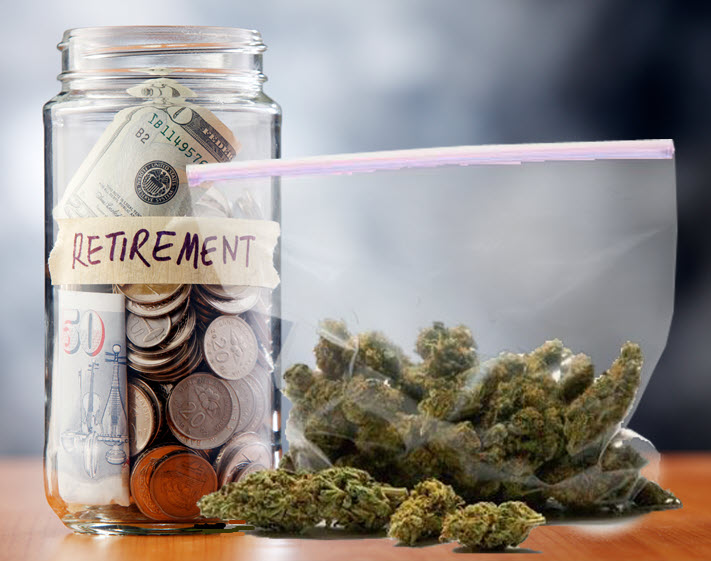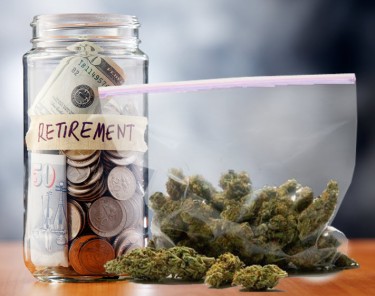Cannabis News
401K Where K Stands for Kush
Published
2 years agoon
By
admin

Reginald Reefer Retirement Plan: Homesteading your way into old age [Stoned]
For as long as I can remember, I have had a vision in my mind – a vision of a retirement plan like no other. As a teenager, the idea first popped into my head, and since then, I’ve held onto it with unwavering determination. I thought to myself, “What if I could solve retirement first? What if I could secure my future so completely that I would be free to live life unapologetically, knowing that my ‘end’ is taken care of?”
With this thought swirling in my mind, I delved deeper into the concept of “solving the end.” And that’s when it hit me – my unique and revolutionary retirement plan was born. I call it the “Reginald Reefer Retirement Plan,” and it revolves around the idea of homesteading my way into old age – a life where I grow my own food and medicine, generate my electricity, gas, and water, all within the least amount of space possible.
Throughout this article, I’m going to share my vision with you, my hopes to inspire you to consider retirement in a completely different light. My aim is to encourage you to start working on your retirement plan as a young person because, believe me, if you manage to pull this off at an early age, the rest of your life will become infinitely easier.
In today’s world, traditional retirement plans often involve saving a significant portion of our earnings, investing in various financial instruments, and hoping that, by the time we reach retirement age, we will have accumulated enough wealth to sustain us through our golden years. But what if there was a way to break free from this standard approach and create a retirement that provides not only financial security but also a deep sense of self-sufficiency and fulfillment? Yes, drug-sniffing dogs are retiring early due to cannabis legalization, but humans need a better plan.
The Reginald Reefer Retirement Plan is based on the principles of homesteading – a way of life that harks back to our ancestors, where they lived off the land and relied on their own skills and resources to meet their needs. But here’s the twist – we’re going to embrace modern technologies and innovations to make this homesteading dream a reality, all while enjoying the benefits of cannabis, which I affectionately refer to as my trusty “bud-ie” in this journey.
Now, you might be wondering, “Why cannabis?” Well, let me explain. Cannabis, for me, is more than just a recreational indulgence. It is a versatile plant with numerous benefits that can play a pivotal role in making our homesteading adventure successful. From medicinal properties to stress relief and creative inspiration, cannabis enhances our connection with the earth and our endeavors to live self-sufficiently.
In the following sections of this article, I will dive deep into the elements that make up the Reginald Reefer Retirement Plan. From creating a compact, self-sustaining homestead to exploring the wonders of cannabis-infused living, we’ll uncover the secrets to a fulfilling and worry-free retirement that goes beyond the conventional norms.
So let’s talk about the general vision first.
What does the “Dream” look like?
Picture this: a self-sustaining homestead, encompassing at least 5 acres of beautiful land. It’s the core of the Reginald Reefer Retirement Plan. This space provides everything I need to thrive and revel in life’s pleasures, all within the smallest footprint possible.
One of the fundamental components of this dream is food and water self-sufficiency. Vertical grow systems and greenhouses are thoughtfully integrated to nurture a rich variety of fruits, vegetables, and herbs. The goal is to create an abundant and diverse harvest year-round, regardless of the seasons.
Water is a precious resource, and so, I’ve designed water collection and conservation systems to ensure I never run dry. Rainwater harvesting becomes a crucial practice, gathering and storing every drop to fulfill all my water needs. The homestead operates on a closed-loop system, where any excess water gets efficiently recycled through advanced filtration, minimizing waste and environmental impact.
Now, the heart of the vision lies in the house itself. I’ve envisioned a state-of-the-art Earthship, an extraordinary dwelling built with recycled materials and earth-based construction techniques. And here’s where it gets even more fascinating. This Earthship is no ordinary home; it’s equipped with the latest smart technology, making it a seamless blend of eco-conscious living and modern convenience.
Imagine stepping into a home that listens and responds to your voice commands, efficiently regulating all activities on the homestead. It’s a living space where technology and nature come together in harmony. To further streamline daily tasks, I’ve integrated robotics to handle routine maintenance, planting, harvesting, and waste management. This allows me to focus on the joys of homesteading and live with greater ease.
But this vision isn’t just about being self-reliant; it extends to creating closed systems that nurture and support each other. The Earthship doubles as a greenhouse, extending my potential for food production while providing a tranquil and natural environment. Here, I find the sweet spot between ecological and high-tech living, maximizing efficiency without sacrificing the beauty of the natural world.
As I bring this vision to life, I’m not just dreaming of an isolated paradise. It’s about fostering a community of like-minded individuals, all embracing this approach to retirement. We share knowledge, resources, and support, creating a network of abundance and freedom.
Grow thy Medicine!
When envisioning a self-sustaining homestead, cultivating a diverse array of medicinal plants becomes an essential part of the Reginald Reefer Retirement Plan. With a focus on natural healing and holistic health, these ten crucial medicinal plants can serve as the foundation for a comprehensive herbal medicine garden.
Cannabis (Cannabis sativa):
At the heart of the medicinal garden stands cannabis, a versatile all-purpose plant with a wide range of therapeutic properties. From pain relief to reducing inflammation, alleviating anxiety, and promoting sleep, cannabis offers a holistic approach to well-being. Its cannabinoids, such as THC and CBD, interact with our endocannabinoid system to promote balance and harmony within the body.
Poppy (Papaver somniferum):
Known for its opium-producing capabilities, the poppy plant offers valuable medicinal properties, especially in pain management. The poppy’s alkaloids can be used to create painkillers, such as morphine and codeine, providing relief for various ailments and conditions.
Coca Plant (Erythroxylum coca):
Contrary to its infamous reputation as the source of cocaine, the coca plant has its own legitimate medicinal uses when unprocessed. Rich in antioxidants, coca leaves have been traditionally used by indigenous populations to combat altitude sickness, fatigue, and aid in digestion.
Aloe Vera (Aloe barbadensis miller):
Aloe vera is a must-have plant for its exceptional healing properties. Its gel-like substance soothes and heals wounds, burns, and skin irritations. Additionally, aloe vera can promote skin hydration, reduce inflammation, and boost the immune system.
Echinacea (Echinacea purpurea):
Echinacea is a powerful immune-boosting herb, known for its ability to strengthen the body’s defenses against infections and illnesses. It can be used to prevent and shorten the duration of colds, flu, and other respiratory infections.
Lavender (Lavandula angustifolia):
Lavender’s delightful aroma has calming effects, making it an excellent choice for stress and anxiety relief. Its essential oil can be used in aromatherapy, while its antiseptic properties help soothe skin conditions and aid in wound healing.
Chamomile (Matricaria chamomilla):
Chamomile is a gentle yet effective medicinal plant, revered for its calming and sedative properties. It’s commonly used to ease anxiety, insomnia, and digestive issues, providing a natural remedy for relaxation and well-being.
Peppermint (Mentha piperita):
Peppermint’s refreshing taste and scent make it a favorite among medicinal plants. Its leaves contain menthol, which helps alleviate digestive discomfort, headaches, and muscle pain. Peppermint tea is a soothing remedy for indigestion and an instant mood booster.
Ginger (Zingiber officinale):
Ginger is a potent medicinal root with anti-inflammatory and antioxidant properties. It aids digestion, relieves nausea, and can reduce muscle pain and soreness. Ginger tea is a warming and comforting beverage to incorporate into your daily routine.
Lemon Balm (Melissa officinalis):
Lemon balm, a member of the mint family, possesses calming and mood-enhancing properties. It can help alleviate anxiety, promote relaxation, and improve sleep quality. Lemon balm tea is a delightful and soothing herbal infusion.
By cultivating these ten medicinal plants on your homestead, you empower yourself with a natural pharmacy that provides relief, healing, and well-being.
In my personal garden I’m also going to be planting some psychedelic plants. For example;
Psilocybin Mushrooms (Psilocybe cubensis):
The mesmerizing beauty of psilocybin mushrooms graces my garden, gifting me with transformative journeys of self-discovery and connection. These sacred fungi have been used by indigenous cultures for millennia, offering profound insights, spiritual revelations, and a deeper understanding of the interconnectedness of all living beings.
Peyote (Lophophora williamsii):
The mystical peyote cactus stands tall in my psychedelic garden, its button-like tops containing mescaline, a potent psychedelic compound. Through ceremonial use and guided exploration, peyote opens the doors of perception, inviting me to explore the cosmos within and without.
Ayahuasca Vine (Banisteriopsis caapi) and Chacruna (Psychotria viridis):
In a harmonious union, the ayahuasca vine and chacruna leaves coexist, giving birth to the sacred brew of ayahuasca. The visionary medicine of the Amazonian rainforest, ayahuasca journeys guide me through profound healing and soul-searching experiences, guiding me towards personal growth and spiritual enlightenment.
San Pedro Cactus (Echinopsis pachanoi):
The majestic San Pedro cactus stands tall as a guardian of ancient wisdom, its mescaline-rich flesh inviting me on a gentle yet profound journey of introspection and understanding. Its teachings are tender and nurturing, like a wise elder embracing me with loving guidance.
Salvia Divinorum (Salvia divinorum):
Salvia divinorum, the enchantress of my garden, is a portal into alternate dimensions and altered states of consciousness. With its short-lived but intense effects, salvia shows me the transient nature of reality and the limitless expanses of the mind.
Morning Glory (Ipomoea tricolor) and Hawaiian Baby Woodrose (Argyreia nervosa):
These entwined vines offer their beautiful flowers and seeds, containing lysergic acid amides (LSA). Their psychedelic properties provide me with visionary insights and a profound connection to nature’s rhythm, dancing under the stars and into the depths of my soul.
As I age gracefully, I will spent my evenings exploring psychedelic spaces, microdosing to create new works as I enjoy the rest of my days knowing that I’m getting all the right food and medicine to make my final days a breeze.
Let’s talk Energy
In my dream homestead, energy is the heartbeat that sustains the entire interconnected ecosystem. Harnessing the power of nature’s elements, I would create a harmonious dance of solar, wind, and hydroelectricity systems to meet our energy needs while treading lightly on the Earth.
Solar power would take center stage, with an array of photovoltaic panels basking in the sun’s warm embrace atop our home and outbuildings. These solar panels would convert sunlight into electricity, providing us with a steady stream of clean and renewable energy throughout the day. The excess energy would be stored in efficient battery banks, ensuring we have power even during cloudy days and at night.
But my energy journey wouldn’t stop with the sun; the playful winds that sweep across our homestead would be harnessed as well. We’d install wind turbines, gracefully turning with each gust, generating additional electricity to complement our solar power. On days when the sun takes a break, the wind would pick up the slack, providing a reliable backup energy source.
As our homestead is blessed with a flowing stream nearby, we’d tap into the power of water through micro-hydroelectric systems. The gentle flow of the water would drive water turbines, converting its energy into electricity. With these interconnected systems, we’d harness the gifts of nature to their fullest potential, ensuring our homestead is self-sufficient and resilient.
But we wouldn’t stop there; innovation and resourcefulness would be our allies. We’d capture the methane produced from our compost and waste systems, repurposing it as a clean and sustainable cooking fuel. Not a single resource would go to waste, as we cultivate a closed-loop system that harmonizes with the natural cycles of life.
The visionary in me would also embark on an experiment with hydrogen power. Utilizing DC currents, we’d separate hydrogen from saltwater through electrolysis, unlocking its potential as a clean and abundant energy source. The hydrogen gas would then be stored for various applications, potentially fueling vehicles or providing supplementary energy to our power grid.
As an AI-integrated homestead, our energy management system would be governed by an intelligent network that optimizes energy usage, storage, and distribution. The AI would constantly monitor energy demand, weather patterns, and available resources, making real-time adjustments to ensure efficiency and sustainability.
Together, these interconnected energy systems would power not only our daily needs but also the advanced technologies that enrich our lives. From automated gardening systems to smart home controls, the AI would be the conductor orchestrating the symphony of energy, resources, and technologies that define our self-sufficient paradise.
Of course, I think that the AI that would run the house would NEED to be on an independent server, custom coded because I would NOT trust anyone else to run that system. It’s the lifeline of the dream and would need a lot of custom work.
What about meat?
In my self-sufficient homestead, I’d embrace a holistic approach to harvest meat and protein, nurturing a harmonious coexistence with nature. Aquaponics would take center stage, as this ingenious system combines aquaculture and hydroponics to provide a sustainable source of fish and fresh vegetables. The fish would thrive in large tanks, their waste rich in nutrients for the plants, and the plants would naturally filter the water, creating a self-sustaining ecosystem.
To supplement our protein needs further, I’d keep a flock of hens, happily clucking and providing us with a steady supply of eggs. The symbiotic relationship between the hens and the aquaponics system would ensure a well-balanced diet and minimal waste.
For meat, we’d also rely on a small herd of goats, allowing them to graze on the land and provide us with a source of fresh and nutritious milk. The occasional surplus of goats could be thoughtfully and sustainably harvested, ensuring we respect the balance of nature and only take what we need.
Additionally, deep-freezing meat would be part of our strategy, preserving any surplus meat from our harvest or hunting trips. Speaking of which, connecting with the primal hunter within, I’d venture into the surrounding wilderness occasionally, embracing the tradition of hunting for food. Wild game would offer a diverse protein source and strengthen our connection to the land.
In this way, our homestead would achieve a remarkable harmony, sustaining us with a variety of protein sources while respecting the cycles of nature. The beauty of such a system lies in its adaptability, providing us with a balanced and nourishing diet that blends the best of modern technology and ancient wisdom. In every meal we share, we’d be reminded of our role as stewards of the Earth, deeply connected to the sustenance it provides us.
The Sticky Bottom Line
At the end of the day, I know that some people will look at this dream and say, “Ew!” However, I believe that this is the way forward. We need to recreate society and we can do this by going to remote places, banning together with other like-minded individuals, and creating a society where we live off the land once again.
I think one of the biggest issues we see in today’s world is unchecked central planning – and when you build independent homesteads like this, and band together with other people – you truly create a world where everyone is working together for a common good.
Will it happen overnight? Of course not!
However, if you can start buying cheap land…I hope this article inspires you to think like I do – and instead of trying to change the system…you just fucking create one yourself!
CANNABIS RETIREMENT PLANS, READ ON…
You may like
-


The Best Tariff Friendly Cocktails
-


Cannabis Consumers Are Being Hit By The Tariffs
-


The Best Tips To Update Your Wardrobe
-


Former New York Knick Iman Shumpert debuts ‘TSA Approved’ legal cannabis brand
-


How New York pot pioneers made it to legal dispensary shelves
-


Scientists Now Think That One Compound in the Cannabis Plant Can Replace All Opiates
Cannabis News
Scientists Now Think That One Compound in the Cannabis Plant Can Replace All Opiates
Published
15 hours agoon
April 3, 2025By
admin

Which Cannabis Compound Do Scientists Think Can Replace Opiates?
…And Why This Is Important
Opiates are a type of pharmaceutical drug that’s been made from the opium poppy plant. While it’s somewhat a ‘natural’ substance that’s been extracted from the fibers and sap of the opium poppy plant, these are extremely dangerous sedatives that act on the central nervous system. However, there are completely synthetic opioids as well, which are manufactured entirely in laboratories.
Famous examples of well-known and widely-used opiates today include heroin, codeine, and morphine. They all work similarly, binding to the brain’s opioid receptors and users feel a drastic reduction in pain. It also causes users to feel euphoric, drowsy, or sleepy. Common side effects include constipation and nausea.
Because opiates are powerful for dulling one’s pain perceptions, they have become commonly prescribed by doctors and hospitals for pain relief. That said, opiates have become one of the world’s most addictive, dangerous, and fatal drugs – and you can get prescribed it right by your very own physician. Repeated use of opiates can easily lead to dependence and addiction, and eventually consuming high doses can drastically slow down breathing, and cause brain damage, or even death.
Since doctors still keep prescribing opioids, this has resulted in the deadly Opioid Epidemic, which has killed thousands of people. It’s a worrisome public health crisis, most especially because of fentanyl, an illegally manufactured opioid which is said to be 50 times more potent than heroin.
Could The Answer To The Opioid Epidemic Lie In Cannabis…Terpenes?
The past few years have shown that cannabis legalization is critical for surviving the opioid epidemic, and reducing overall opioid consumption.
The results of a recent research paper, which builds on past studies conducted by Dr. John Streicher, who is a member of the Comprehensive Center for Pain and Addiction, reveals fascinating findings. According to Streicher, cannabis terpenes were found to provide relief in inflammation models as well as on neuropathic pain caused by chemotherapy.
For the study, Streicher and his research team analyzed 4 kinds of terpenes that are found in mid to high levels in Cannabis sativa plants: linalool, geraniol, beta-caryophyllene, and alpha-humulene. They discovered that each terpene produced significant pain relief among mice subjects with fibromyalgia and post-operative pain, and among the terpenes, geraniol was found to be the most powerful.
“Our research is showing that terpenes are not a good option for reducing acute pain resulting from an injury, such as stubbing your toe or touching a hot stove; however, we are seeing significant reductions in pain when terpenes are used for chronic or pathological pain,” he said. “This study was the first to investigate the impact of terpenes in preclinical models of fibromyalgia and post-operative pain and expand the scope of potential pain-relieving treatments using terpenes,” Streicher said.
Cannabis terpenes are the compounds responsible for the aromatic profile of each strain; they are located in the plant trichomes. Not only do they contribute to each strain’s unique flavor and odor, but they also have valuable therapeutic and medicinal benefits. There are around 150 kinds of terpenes known today, though in the entire plant world, there are known to be some 20,000 terpenes.
Understanding the therapeutic benefits of terpenes is incredibly valuable also because they don’t contain THC (tetrahydrocannabinol), the compound in marijuana that gets you high.
“With fibromyalgia, there isn’t much of an understanding of what the pain state is, and there are not a lot of great options for treating it,” explains Streicher. “Our findings show that terpenes may be a viable treatment option for fibromyalgia pain, which could potentially have a large impact and make a difference for an under-treated population.”
Other Studies
This is not the first time that cannabis terpenes have been found to demonstrate excellent pain-relieving properties. It must be noted that just like what Streicher says, terpenes seem to do better with chronic pain management, instead of acute pain management.
Another study from 2024, which was published in The Journal of the Association for the Study of Pain, was conducted by researchers at the University of Arizona and the National Institutes of Health. The investigators analyzed the analgesic properties of different terpenes including geraniol, humulene, linalool, pinene, and caryophyllene among mice subjects with chemotherapy-induced peripheral neuropathy.
According to the researchers, all the terpenes delivered analgesic effects that were equivalent to around 10 mg/kg of morphine. It was also interesting to note that administering both morphine and terpenes together at low doses resulted in ‘enhanced’ pain-killing effects.
“Together these studies identify cannabis terpenes as potential therapeutics for chronic neuropathic pain,” said the investigators.
There have also been other studies that have found that combining cannabis with opioids can indeed provide long-lasting pain relief. It comes with the added benefit of reducing opioid doses needed for effective pain control. This phenomenon is called opioid-sparing. These types of protocols can be beneficial for patients who suffer from severe, chronic pain caused by cancer, arthritis, joint problems, fibromyalgia, diabetes, post-surgical pain, migraines, nerve damage, and so much more.
Conclusion
Learning more about the pain-killing properties of terpenes is extremely valuable for the medical community, patients, and even society as a whole. We can all do with less opioid addictions because it has torn families apart, and caused the deaths of thousands of people.
Terpenes, or cannabis in general, offer a natural and safe alternative that can be complementary to other pharmaceutical treatments designed to reduce pain.
SWAPPNG OPIOIDS FOR CANNABIS, READ ON…


Cannabis and the Authoritarian State
Cannabis has been legal for longer than it has been illegal. Let that sink in for a minute. For thousands of years, humans cultivated and consumed cannabis freely across civilizations and continents. It wasn’t until the early 1900s that we witnessed a massive push to drive hemp and cannabis into the black market, primarily due to industrial competition from petrochemicals, pharmaceuticals, and other industrial applications.
What makes cannabis so threatening to powerful interests? For starters, hemp and cannabis are highly versatile crops with over 50,000 different uses, from medicine to textiles to fuel. Even more remarkable is how this plant is hardwired to work with the human body through our endocannabinoid system—a biological network we didn’t even discover until the 1990s.
Perhaps most threatening of all is that cannabis is insanely easy to grow. This means that if the plant helps you with a particular physical ailment, you have the ability to grow your own medicine indefinitely. No insurance premiums, no wait lists, no pharmaceutical middlemen—just you cultivating your own healing directly from the earth.
Authoritarians do not like this, not one bit. When people can meet their own needs independently, power structures lose their grip. When citizens can think differently without permission, control systems begin to fail. So today, we’re going to look at the interesting relationship between authoritarianism and cannabis, and how this humble plant plays a key role in keeping you free.
We’ve already established the versatility of cannabis, but there’s another element that those old D.A.R.E. PSAs inadvertently reveal about what authoritarians think about cannabis. I’m talking, of course, about “behavior.” You see, in an authoritarian system, you and I are but cogs in the machine. We’re the expendables who should be proud to work ourselves to death for our “fearless leaders.”
This is precisely why certain ideas, philosophies, religions, movements, books, and substances are typically banned in authoritarian regimes. Take North Korea as an example: everything from the type of television citizens watch to the music they hear is a tightly spun spell designed to keep the populace in check. While they don’t have explicit laws against hemp (they actually grow it industrially), smoking psychoactive cannabis is strictly forbidden.
Contrast this with places like Malaysia, where you can get up to 5 years for possessing just 20 grams of cannabis, and even face the death penalty depending on the situation. These authoritarians don’t play around when it comes to cannabis because they know it affects the behavior of their populace in ways they can’t control.
The question becomes: what behavior do they fear so much that cannabis produces within the individual?
The answer is a critical mind. People who consume cannabis often begin to question their own belief systems. Most regular users undergo some transformation in their values and perspectives. Cannabis has a unique way of helping people see beyond cultural programming and think outside established paradigms. It can make the familiar strange and the strange familiar—a psychological state that’s antithetical to authoritarian control.
This independent thinking runs counter to the narrative of authoritarians who wish to maintain a tight grip on social consciousness. If even 10% of a population begins to pivot in their behavior within a regime, it can have massive ripple effects. Just look at cannabis in the US—it went from being demonized to being embraced by the majority in less than 80 years, despite massive propaganda efforts.
For authoritarians, psychoactive cannabis isn’t primarily a threat to public health and wellbeing—it’s a threat to the health and wellbeing of authoritarianism itself. When people start thinking differently, they start living differently. When they start living differently, they start demanding different. And that’s the beginning of the end for any system built on unquestioning obedience.
Beyond the threat to thought control, there’s another reason why drugs in general remain illegal: the state can use prohibition as a weapon against the populace. This isn’t conspiracy theory—it’s documented history.
Take Nixon’s war on drugs. His domestic policy chief, John Ehrlichman, later admitted: “We knew we couldn’t make it illegal to be either against the war or black, but by getting the public to associate the hippies with marijuana and blacks with heroin, and then criminalizing both heavily, we could disrupt those communities.” Nixon essentially placed cannabis on the Controlled Substances Act because he needed an excuse to shut down anti-war protests and target Black communities.
Since hippies and anti-war protesters were smoking “freedom grass,” making it illegal would circumvent their freedom of speech and freedom of assembly, and more importantly—turn free citizens into state property. It’s a win-win if you’re an authoritarian looking to silence dissent.
Then there’s the whole “boogeyman” complex that prohibition creates. We’re told “drug dealers” are roaming the streets preying on innocents, giving them “marihuanas” so they can do vile things. What the government conveniently leaves out is how the banks these “dealers” use to launder their money remain untouched. They don’t mention the shadier dealings of law enforcement either—like running guns into Mexico (eventually leading to the death of one of their own), or spraying poison on crops, killing and hospitalizing people because, you know…”Drugs are bad!”
Authoritarians cannot let go of the value that keeping the most widely used illicit substance in the world illegal provides them. This explains why the US hasn’t federally legalized cannabis despite nearly 80% of Americans supporting some form of legalization. It’s not because they don’t have enough research or that they’re genuinely concerned about public health—it’s because prohibition gives them all the privileges of violating constitutional rights while siphoning money into their coffers.
Drug prohibition creates a perpetual enemy that can never be defeated, allowing endless justification for surveillance, militarized police, asset forfeiture, and expansion of state power. What authoritarian could resist such a convenient tool?
Cannabis is a plant. You can’t make nature illegal—it’s counter to the human experience. When governments attempt to criminalize a naturally occurring organism that humans have cultivated and used for thousands of years, they reveal the absurdity of their position and the limits of their authority.
While the United States isn’t a full-on authoritarian state (yet), the truth is that many authoritarian elements have played out over the years. You only need to look as far as the war on drugs to see how the state utilizes prohibition as a weapon to their advantage. From no-knock raids to civil asset forfeiture to mass incarceration, drug laws have erected a parallel legal system where constitutional protections often don’t apply.
The fundamental truth is that cannabis is not only versatile and medicinal, it gives you back your autonomy in multiple ways. It helps you think for yourself. It allows you to grow your own medicine. It connects you with a plant that humans have used ceremonially, medicinally, and industrially throughout our history. And this autonomy is something authoritarians cannot stand—free individuals who know how to think beyond the narratives they’re fed.
Cannabis doesn’t just get you high—it offers a perspective from which the absurdities of prohibition become glaringly obvious. Perhaps this is why, as state after state legalizes, we’re witnessing the slow but steady unraveling of one of the most enduring authoritarian policies in American history.
So if you count yourself among those who value freedom of thought and bodily autonomy, who believe that nature doesn’t require government permission, and who understand that true liberty includes the right to explore your own consciousness—well, maybe it’s time to toke one up for freedom!
LEGALIZING CANNABIS IS NOT ENOUGH, READ ON..
Cannabis News
Stop Using Bat Poop to Fertilize Your Weed Plants Immediately, Here is Why…
Published
3 days agoon
April 1, 2025By
admin

Don’t Fertilize Your Weed with Bat Poop
Fertilization is a critical step for growing healthy marijuana plants.
They help provide essential nutrients for marijuana in various stages of growth, while promoting plant growth. There are dozens of different fertilizers to choose from in the market; growers can choose based on budget, nutrients needed, location, season, and much more. But not all fertilizers are made equally – of course, some are of better quality than others.
That said, there are some rather unusual fertilizers that can be used on plants. These may include, but are not limited to: coffee, milk, grass clippings, banana peels, fish tank water, potato water, and even urine! Yes, it does sound strange, but to gardening enthusiasts, there is nutritional value to be found in each of these things, which can make them suitable fertilizers depending on the circumstances.
For example, grass clippings make excellent mulch and can provide potassium, nitrogen, and phosphorus. Urine is a potent source of nitrogen as well as phosphorus. Banana peels are rich in calcium, which is excellent for promoting root growth while helping supply oxygen to the soil.
But what about bat poop? Also known as guano, bat poop has been said to work as a plant fertilizer because it’s rich in nitrogen, potassium, phosphorus, and other nutrients. Unfortunately, using bat poop as a plant fertilizer can also be dangerous. So if you don’t really know what you are doing, bat poop as a fertilizer can be extremely risky.
Bat Poop Fertilizer Kills 2 NY Men
On December 2024, news of two men hailing from Rochester, New York, dying went viral.
The cause of death was dangerous fungus, in the bat poop that they were using to fertilize their marijuana plants. Both men grew their own marijuana plants for medical consumption, but unfortunately developed histoplasmosis after breathing toxic fungal spores from the guano.
One of the men was aged 59 years old; he bought bat poop online to use as fertilizer for his plants. Meanwhile, the other was a 64-year-old male who found guano in his attic, then decided to use it to fertilize his cannabis plants. They both developed similar symptoms, including chronic coughs, fever, severe weight loss, and respiratory failure. The case was also discussed in the Open Forum Infectious Diseases medical journal.
Is there a safe way to use bat poop as fertilizer? If you ask me, I truly can’t understand why one would use guano as fertilizer when there are so many other proven safe alternatives out there that are simply not as risky. According to the University of Washington, one must always wear a dust mask each time you open a bag containing soil amendments. That’s because a mask will greatly decrease the chances of breathing in fungal spores, which could be potentially dangerous. They also go on to explain that yes, guano is indeed used as fertilizer for its valuable nitrogen content but it still isn’t without its own risks, particularly of developing Histoplasma – the same condition that killed the two men.
Make Your Own Safe Fertilizers At Home
There are many other safe, affordable – and even free – fertilizers you can feed your marijuana plants with. It doesn’t have to cost a fortune nor does it have to be risky to your health.
Check out these easy, low-cost, DIY fertilizers for weed:
-
Coffee grounds are abundant in nitrogen, which makes it perfect for the vegetative stage of marijuana plants. They are also a fantastic source of organic materials and green waste, which contain other vital nutrients. When the coffee grounds decompose, they create soil aggregates that improve soil aeration and its water retention capabilities.
Mix around 2 grams of coffee ground for every liter of soil. Measuring its pH levels is also helpful, since you want it to be between 6 to 6.5
-
Crushed eggshells are a great way to ensure no eggshells go to waste. It’s rich in calcium plus other minerals that are effective in improving overall plant structure, health, and growth. In fact, so many gardeners and farmers commonly use crushed eggshells to help boost plant growth – and it will work just as well for marijuana plants.
They’re really easy to use, too! Just mix eggshells into the soil, or steep them into water then pour into the soil for a calcium-packed feed.
-
Banana tea or water is rich in potassium and magnesium, making it perfect as a feed during the marijuana plant’s flowering stage. You can use banana peels differently: with 3 to 5 banana peels, soak it in water for 2 days. Then you can use the water on your plants, and even leave the banana peels as compost for your garden.
-
Wood ash from your fireplace or other sources is a great source of phosphorus and potassium. Simply sprinkle some wood ash over marijuana during the final flower phase. Just use 1 or 2 grams of ash for every liter of substrate. Be careful not to use too much wood ash, or it can make the soil too alkaline.
-
Animal manure, such as those from cows, rabbits, or horses, make excellent organic fertilizers. Just be sure that they’re composed properly so that you avoid introducing weed seeds, or pathogens.
These low-cost fertilizers are also natural and effective. There’s no reason for you to turn to bat poop as fertilizer, even if you’re in a bind.
Conclusion
Guano or bat poop is a poor choice of fertilizer if you don’t know what you are doing. It’s risky and potentially dangerous – just not worth it. Instead, fertilize your marijuana plants with these options mentioned.
BEST POOP FOR CANNABIS PLANTS, KEEP READING…

The Best Tariff Friendly Cocktails

Cannabis Consumers Are Being Hit By The Tariffs

The Best Tips To Update Your Wardrobe

Former New York Knick Iman Shumpert debuts ‘TSA Approved’ legal cannabis brand

How New York pot pioneers made it to legal dispensary shelves

Scientists Now Think That One Compound in the Cannabis Plant Can Replace All Opiates

Vladimir Bautista is leading Happy Munkey’s legacy-to-legal takeover

Cannabis Can Help A Sore Throat

Cannabis and the Authoritarian State

As cannabis consumer tastes evolve, industry must look beyond potency

Distressed Cannabis Business Takeaways – Canna Law Blog™

United States: Alex Malyshev And Melinda Fellner Discuss The Intersection Of Tax And Cannabis In New Video Series – Part VI: Licensing (Video)

What you Need to Know

Drug Testing for Marijuana – The Joint Blog

NCIA Write About Their Equity Scholarship Program

It has been a wild news week – here’s how CBD and weed can help you relax

Cannabis, alcohol firm SNDL loses CA$372.4 million in 2022

A new April 20 cannabis contest includes a $40,000 purse

Your Go-To Source for Cannabis Logos and Designs

UArizona launches online cannabis compliance online course
Trending
-

 Cannabis News2 years ago
Cannabis News2 years agoDistressed Cannabis Business Takeaways – Canna Law Blog™
-

 One-Hit Wonders2 years ago
One-Hit Wonders2 years agoUnited States: Alex Malyshev And Melinda Fellner Discuss The Intersection Of Tax And Cannabis In New Video Series – Part VI: Licensing (Video)
-

 Cannabis 1012 years ago
Cannabis 1012 years agoWhat you Need to Know
-

 drug testing1 year ago
drug testing1 year agoDrug Testing for Marijuana – The Joint Blog
-

 Education2 years ago
Education2 years agoNCIA Write About Their Equity Scholarship Program
-

 Cannabis2 years ago
Cannabis2 years agoIt has been a wild news week – here’s how CBD and weed can help you relax
-

 Marijuana Business Daily2 years ago
Marijuana Business Daily2 years agoCannabis, alcohol firm SNDL loses CA$372.4 million in 2022
-

 California2 years ago
California2 years agoA new April 20 cannabis contest includes a $40,000 purse







